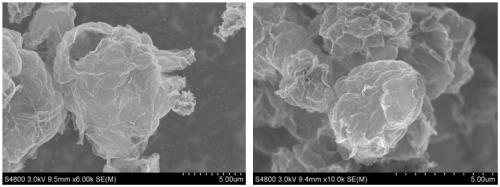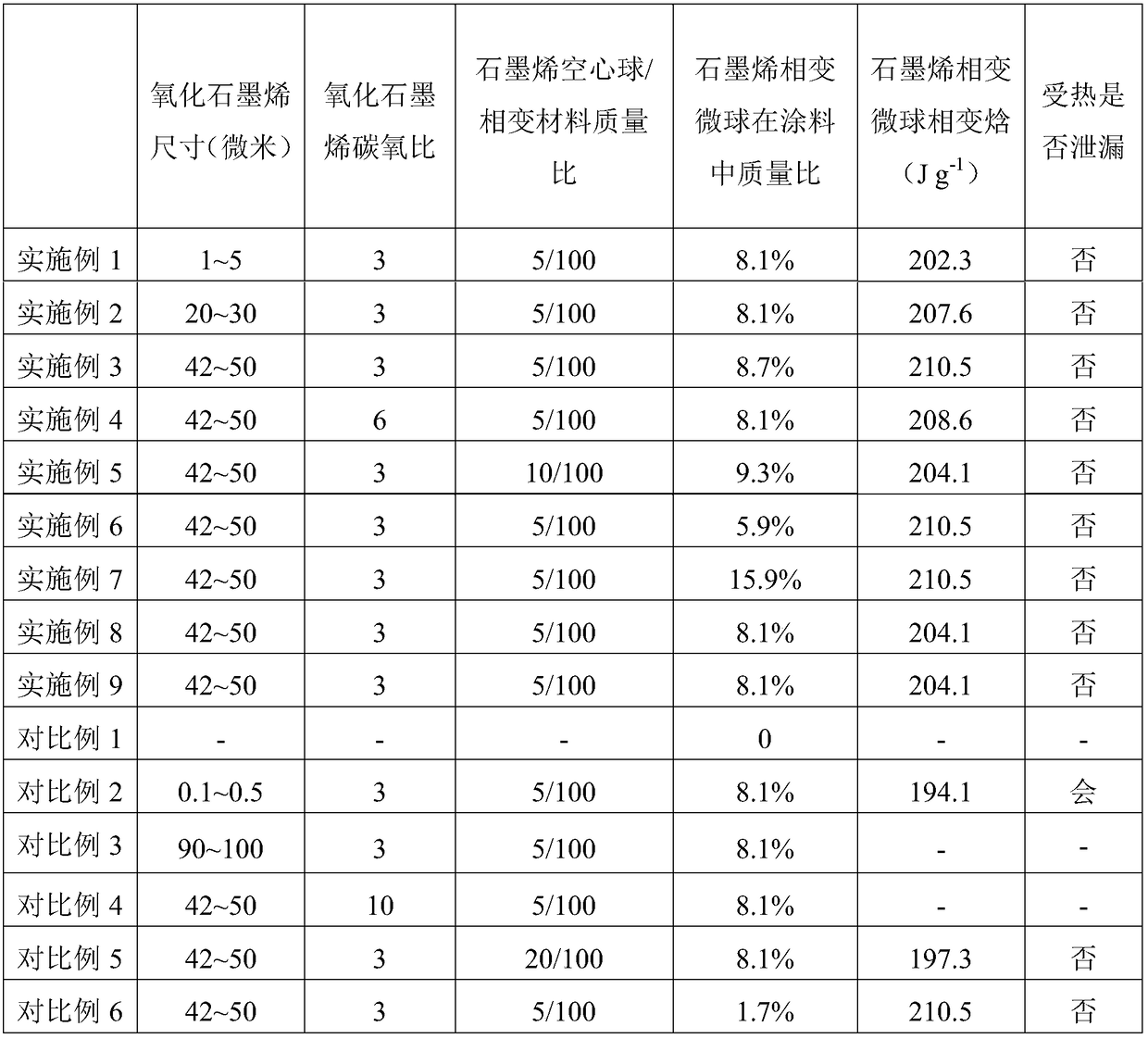Phase-change temperature regulation coating and preparation method thereof
A technology of phase change materials and coatings, applied in conductive coatings, antifouling/underwater coatings, coatings, etc., can solve the problem that the thermal conductivity of materials cannot be improved, it is difficult to ensure the effective coating of phase change materials, and the phase change performance is not improved. and other problems, to achieve the effect of realizing thermal response, fast thermal response, and improving temperature regulation performance
- Summary
- Abstract
- Description
- Claims
- Application Information
AI Technical Summary
Problems solved by technology
Method used
Image
Examples
Embodiment 1
[0027] (1) Drying the single-layer graphene oxide dispersion liquid with a size of 1-5 microns by atomization drying method to obtain graphene oxide microspheres with a carbon-to-oxygen ratio of 3. The atomization drying temperature is 130°C.
[0028] (2) Place the graphene oxide microspheres obtained in step (1) in a tube furnace, raise the temperature to 1300° C. at 10° C. / min, and keep it warm for 1 hour to obtain graphene hollow microspheres.
[0029] (3) Mix 100 parts by mass of eicosane and 5 parts by mass of graphene hollow microspheres, heat to 40° C. to melt the eicosane, then fully stir for 30 minutes, leave to stand for vacuum degassing for 1 hour, and then press filter at 50° C. After cooling, graphene phase change microspheres are obtained.
[0030] (4) Add 30 parts of styrene-acrylic emulsion, 0.3 part of sodium polyphosphate, 70 parts of titanium dioxide, 180 parts of water and 25 parts of graphene phase change microspheres into the reactor for stirring; then a...
Embodiment 2
[0033] (1) Dry the single-layer graphene oxide dispersion liquid with a size of 20-30 microns by atomization drying method to obtain graphene oxide microspheres with a carbon-to-oxygen ratio of 3. The atomization drying temperature is 130°C.
[0034] (2) Place the graphene oxide microspheres obtained in step (1) in a tube furnace, raise the temperature to 1300° C. at 10° C. / min, and keep it warm for 1 hour to obtain graphene hollow microspheres.
[0035] (3) Mix 100 parts by mass of eicosane and 5 parts by mass of graphene hollow microspheres, heat to 40°C to melt the eicosane, then fully stir for 60 minutes, leave to stand for vacuum degassing for 1 hour, and press filter at 50°C, After cooling, graphene phase change microspheres are obtained.
[0036] (4) Add 30 parts of styrene-acrylic emulsion, 0.6 parts of sodium polyphosphate, 70 parts of titanium dioxide, 180 parts of water and 25 parts of graphene phase change microspheres into the reactor for stirring; then add 0.5 p...
Embodiment 3
[0039] (1) Dry the single-layer graphene oxide dispersion liquid with a size of 42-50 microns by atomization drying method to obtain graphene oxide microspheres with a carbon-to-oxygen ratio of 3. The atomization drying temperature is 130°C.
[0040] (2) Place the graphene oxide microspheres obtained in step (1) in a tube furnace, raise the temperature to 1300° C. at 10° C. / min, and keep it warm for 1 hour to obtain graphene hollow microspheres.
[0041](3) Mix 100 parts by mass of eicosane and 5 parts by mass of graphene hollow microspheres, heat to 40°C to melt the eicosane, then fully stir for 20min, leave to stand for vacuum degassing for 1h, and then press filter at 50°C, After cooling, graphene phase change microspheres are obtained.
[0042] (4) Add 30 parts of styrene-acrylic emulsion, 0.3 part of sodium polyphosphate, 60 parts of titanium dioxide, 170 parts of water and 25 parts of graphene phase change microspheres into the reactor for stirring; then add 1 part of d...
PUM
| Property | Measurement | Unit |
|---|---|---|
| particle diameter | aaaaa | aaaaa |
| phase transition temperature | aaaaa | aaaaa |
| size | aaaaa | aaaaa |
Abstract
Description
Claims
Application Information
 Login to View More
Login to View More - R&D
- Intellectual Property
- Life Sciences
- Materials
- Tech Scout
- Unparalleled Data Quality
- Higher Quality Content
- 60% Fewer Hallucinations
Browse by: Latest US Patents, China's latest patents, Technical Efficacy Thesaurus, Application Domain, Technology Topic, Popular Technical Reports.
© 2025 PatSnap. All rights reserved.Legal|Privacy policy|Modern Slavery Act Transparency Statement|Sitemap|About US| Contact US: help@patsnap.com



